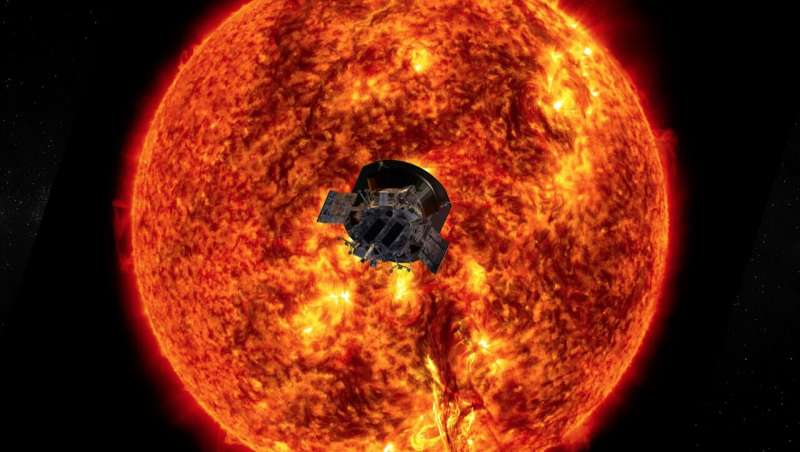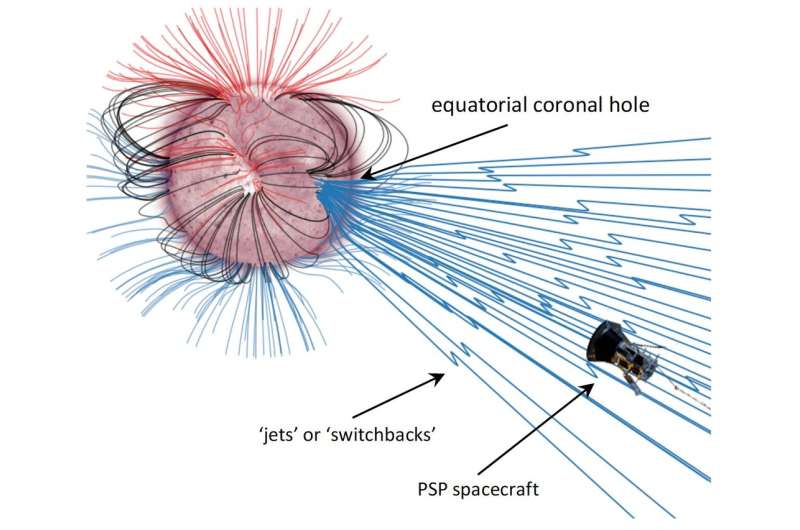Parker Solar Probe traces solar wind to its source on sun's surface: coronal holes

A year ago, NASA's Parker Solar Probe flew closer to the sun than any satellite in history, collecting a spectacular trove of data from the very edge of the sun's million-degree corona.
Now, that data has allowed solar physicists to map the source of a major component of the solar wind that continually peppers Earth's atmosphere, while revealing strange magnetic field reversals that could be accelerating these particles toward our planet.
These accelerated particles interact with Earth's magnetic field, generating the colorful northern and southern lights. But they also have the potential to damage the electrical grid and telecommunications networks on Earth's surface, threaten orbiting satellites and perhaps endanger astronauts in space.
The more solar physicists understand about the magnetic environment of the sun and how it flings solar wind particles toward the planets, the better they will be able to predict events and prevent damage.
"There was a major space weather event in 1859 that blew out telegraph networks on Earth and one in 1972 that set off naval mines in North Vietnam, just from the electrical currents generated by the solar storm," said Stuart Bale, a University of California, Berkeley, professor of physics and lead author of an article about new results from the probe's FIELDS experiment. "We're much more of a technological society than we were in 1972, the communications networks and the power grid on Earth are extraordinarily complex, so big disturbances from the sun are potentially a very serious thing. If we could predict space weather, we could shut down or isolate parts of the power grid, or shut down satellite systems that might be vulnerable."
The journal Nature will post these findings online on Dec. 4 in one of four papers describing all the new findings from the probe's 2018 close encounter with the sun. All four papers will appear in the Dec. 12 print edition of the journal.
Coronal holes
One of the main goals of the Parker Solar Probe is to discover the source of the "slow" solar wind and how it is accelerated in the hot atmosphere of the sun—the 1 million-degree Celsius (about 2 million degrees Fahrenheit) solar corona. The solar wind consists of charged particles, mostly protons and helium nuclei, traveling along the sun's magnetic field lines. The so-called "fast" solar wind, clocked at between 500 and 1,000 kilometers per second, is known to come from large holes in the solar corona at the sun's north and south poles. But the origin of the "slow" solar wind, which is denser but about half the speed of the "fast" solar wind, is more poorly understood.
The data from the probe's first close encounter—the probe has since had two other intimate encounters during the closest approach, or perihelion, of its orbit around the sun—reveals a wealth of new physics.
"The first three encounters of the solar probe that we have had so far have been spectacular," said Bale, the principle investigator for FIELDS. "We can see the magnetic structure of the corona, which tells us that the solar wind is emerging from small coronal holes; we see impulsive activity, large jets or switchbacks which we think are related to the origin of the solar wind; we see instability—the gas itself is unstable and is generating waves on its own. And we are also surprised by the ferocity of the dust environment in the inner heliosphere."

During each close encounter, the probe parked for as long as a week above a coronal hole that was streaming solar wind particles along magnetic field lines past the probe, giving instruments aboard the probe an unprecedented look at what was happening on the solar surface below.
Thanks to extreme ultraviolet mapping of the sun by other spacecraft, such as STEREO, Bale and his colleagues were able to trace the wind and the magnetic fields back to a source—coronal holes—that strongly suggests that these holes are the source of the slow solar wind. Coronal holes, which are related to sun spots, are areas that are cooler and less dense than the surrounding corona.
What was unexpected was a series of flips in the magnetic field as it streamed past the spacecraft. During these periods, the magnetic field suddenly reversed itself by 180 degrees and then, seconds to hours later, flipped back.
"These switchbacks are probably associated with some kind of plasma jets," Bale said. "My own feeling is that these switchbacks, or jets, are central to the solar wind heating problem."
Comet dust
Another surprise was the dust that peppered the spacecraft repeatedly during each fly-by at perihelion—the point in the orbit where the spacecraft was closest to the sun. Probably smaller than a micron, which is a thousandth of a millimeter, the dust particles are likely debris from asteroids or comets that melted near the sun and left behind their trapped dust. That dust is now orbiting the sun, and Bale suspects that much of it that hitting the spacecraft is being ejected outward by light pressure and destined to escape the solar system entirely.
Bale said that studying the solar wind from Earth is like studying the source of a waterfall from near the bottom, where the turbulence obscures what's happening at the top.
"Now, with the Parker Solar Probe, we are getting closer and closer to the top of the waterfall, and we can see that there is underlying structure," he said. "At the source, what we see is something that is coherent with impulsive jets on top of it. You have a small hole—a coronal hole—and the solar wind is coming out of that in a smooth flow. But then, on top of it, there are jets. By the time you get all the way downstream from it at Earth, it is all just mixed up."
Bale will discuss results from the first close encounter and compare them to those of the two subsequent close encounters in talks at the upcoming American Geophysical Union meeting in San Francisco that starts Dec. 8.
"We have been working nearly around the clock for a decade on this thing, so to see the data ... it is just a pleasure," Bale said. "It is a big case of delayed gratification, but it is terrific stuff."
More information: Highly structured slow solar wind emerging from an equatorial coronal hole, Nature (2019). DOI: 10.1038/s41586-019-1818-7 , nature.com/articles/s41586-019-1818-7
Related:
Alfvénic velocity spikes and rotational flows in the near-Sun solar wind, Nature (2019). DOI: 10.1038/s41586-019-1813-z , nature.com/articles/s41586-019-1813-z
Probing the energetic particle environment near the Sun, Nature (2019). DOI: 10.1038/s41586-019-1811-1 , nature.com/articles/s41586-019-1811-1
Near-Sun observations of an F-corona decrease and K-corona fine structure, Nature (2019). DOI: 10.1038/s41586-019-1807-x , nature.com/articles/s41586-019-1807-x
Journal information: Nature
Provided by University of California - Berkeley




















